It seems strange to be writing a retrospective article and launching it on this very much 21st-century medium of the internet! However, the football club’s rather sad decision to scrap matchday programmes (whether physical or digital) has led to a massive outpouring of support for the continuation of my Retro Reds articles.
As a result of this support – which at the last count amounted to three people – I have been talked into trialling an online version of these articles, with a slightly different name, incorporating our “proper” nickname (since the early 1960s) and reverting to the slightly longer articles, dating from when I first took up the reins from the sadly missed Ian Hands in 2015. Prior to Ian, we had fine content from others such as John Barnett and club history “professor” Tony Pope.
I know there were financial pressures in the decision to scrap programmes, but as we lose more and more links with our past, I think it is important that we jog people’s memories – or in some cases, wake them up to the fact that we did have a club prior to 2010!
The articles will not all be deadly serious, may well gently poke fun at events and characters from our past, but will always stem from a genuine love for the club. It is a club that has meant so much to me and my family ever since my dad started playing for the team just after World War Two and then started taking me to watch games (or, more usually, to play with other children, oblivious to the actual football) at Town Meadow in the mid-1950s. For the younger reader, the “playground” for us kids would have been roughly where Cineworld is now, with the pitch now covered by its car park.
Crawley have played at various locations around the town since the 1890s, and in fact we have an exhibition in the planning stages which will celebrate the history of Crawley Town FC. The exhibition will be staged at Crawley Museum from early December, so keep an eye out for announcements.
As some of us are bemoaning the demise of the programmes, I thought I would start my first piece by looking back at some programmes through the ages and the matches they represented.
My first one takes us back to 1929, when Crawley FC were – as was mainly the case prior to the 1950s – an amateur side made up of almost exclusively local lads, playing in the West Sussex League. This was before the modern new town, when the population was less than 6,000.
Probably our greatest achievement up to that time had been winning the Sussex Intermediate Cup in 1928, defeating Hailsham 6-1 in the final at Haywards Heath. That might seem small beer these days, but it was a very prestigious competition at the time. We even had a special train running for supporters!
But back to 12th October 1929, and another cup game, this time in the FA Amateur Cup, an even more prestigious national competition, which we had started entering the previous season, probably as a result of the success achieved in the Intermediate Cup (we also started entering the Sussex Senior Cup due to that victory).
Unfortunately none of these subsequent cup entries brought us glory; rather exits in the first two rounds (and those second-round visits due to byes) of each would follow. And the game on 12th October would be as painful a loss as any, with a 6-0 defeat at home to our neighbours Horsham.
Our home pitch at the time was Victoria Hall Meadow, roughly in the area of the Dyers Almshouses in Northgate Road (opposite the entrance to Ifield Avenue from London Road). According to the West Sussex Times, a big crowd had gathered for this match against the much stronger Horsham side, who played in the Sussex County League (we often played their reserves in league matches). The sparse programme notes do label them “old rivals”, and another programme I have seen states that at various times in the past, special trains would run between the towns for certain matches (Horsham had a population around twice Crawley’s at the time).
From the match report, it sounded like generally one-way traffic, with Crawley defending gallantly against relentless pressure but still finding themselves 4-0 down at the interval. The report also noted the rough state of the ground, which at the time was often fields loaned by local farmers, a far cry from today’s manicured lawns.
The second half seemed much as the first, although Crawley did hit the bar through Fieldwick. But they were grateful for the fine display of Baker in the home goal, who kept the final score down to 6-0.
Our team was as shown in the programme, with the exception that A. N. Other(!) turned into A. Morgan. Horsham lined up as per the programme listing. I wonder who won the clock given away to the “Lucky Programme” winner?
For our next programme, we jump forward ten years to 6th May 1939 when, after a turbulent ten years, we now find ourselves in the Brighton League. The thirties had seen the club cease playing matches for some time, although it seems from the list of officials that some of the figures previously associated with the club, including G. F. H. Banks (involved since the 1890s), were still much to the fore in resurrecting the playing side of Crawley FC after the short hiatus.
This game against Broadwater was at our home ground, Malthouse Road, roughly between Brighton Road and Malthouse Road, although there was likely to be more than one pitch used in the area during the first half of the 20th century. It was the final game of what seems to have been a disappointing season, although third place was achieved. In this game which we drew 2-2 we had let slip a 2-0 lead, conceded a penalty (saved by Briggs) and nearly lost a game which, according to reports, we should have won “but for the farcical efforts of the forwards”.
Bearing in mind the impending war, football must have been both a nice distraction as well as an irrelevance, and this would be Crawley FC’s last league season until the war was over. However, the Supporters Club were active fundraisers during the war, and also organised dances to entertain the Canadian Forces billeted around the town. Some of the events would take place in the club hut behind the Ancient Priors in the High Street.
Moving forward another ten years, to 23rd April 1949, and a home game against Southwick reserves. Although still in the Brighton League, we had moved ground yet again, to Yetmans Field, our home since football resumed at the end of the war in 1945. It was situated roughly where the Sunnymead flats are today in West Green, just off the Driftway pathway which is still in place just north of the new Travelodge, at the start of London Road.
This match against Southwick held special significance as it was to be our last league match played at Yetmans Field ahead of the move the next season to Town Meadow. It also held significance for our family as my dad, John Fox, played in goal in this match, which we drew 2-2. I was pleased to read in the Crawley Observer match report that, in front of a large crowd, “Fox was never overworked but when called upon he acquitted himself with credit.” He even managed to punch a shot onto the bar, turn round and catch the rebound!
Jumping forward just a couple of months to our next programme, and as well as playing in the last league game at Yetmans Field, Dad also played in the first game at the new ground of Town Meadow when we entertained Goldstone from Brighton in a Brighton League match on 17th September 1949, which we unfortunately lost 1-0. Thankfully, a first win at our new ground came the following Saturday, 24th September 1949, with Dad in goal, when we prevailed 3-2 over Brighton O.G.
As many will know, Town Meadow (picture in around 1950 and known as Town Mead by some in later years) would be our home for many years until Crawley Council relocated us to Broadfield Stadium in 1997 to enable the building of Crawley Leisure Park.
Next time I will try and feature programmes more recognisable to more of our current support, any suggestions let me know. Also if anybody has any memories to share, photos or programmes of interest please get in touch by email to mjfjo@yahoo.co.uk
I would like to thank our club history supremo Tony Pope for sharing some of his extensive research. Also there are many of mine & other fans photos and history on Ian Mulcahy’s excellent (& still growing!) site www.ctfchistory.co.uk
Mick Fox
August 2023
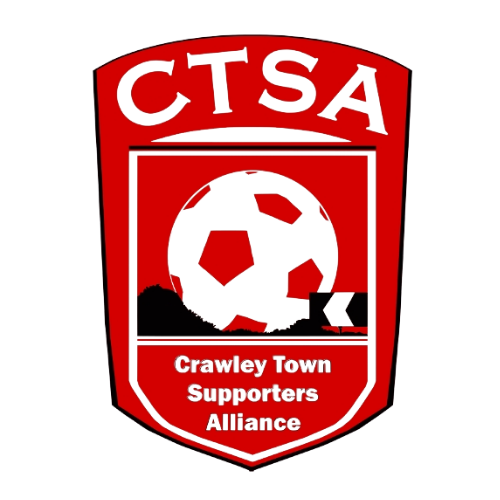
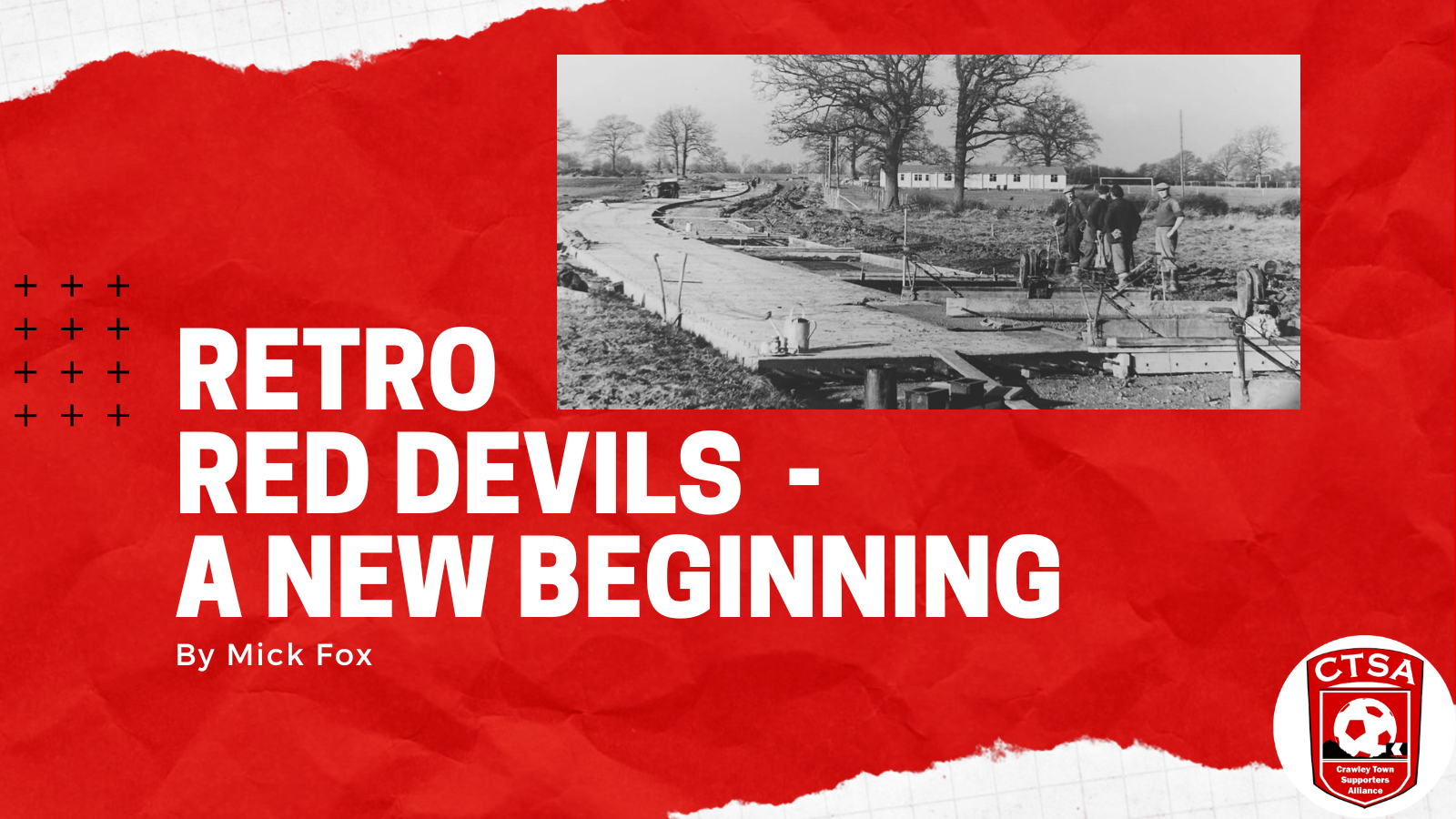
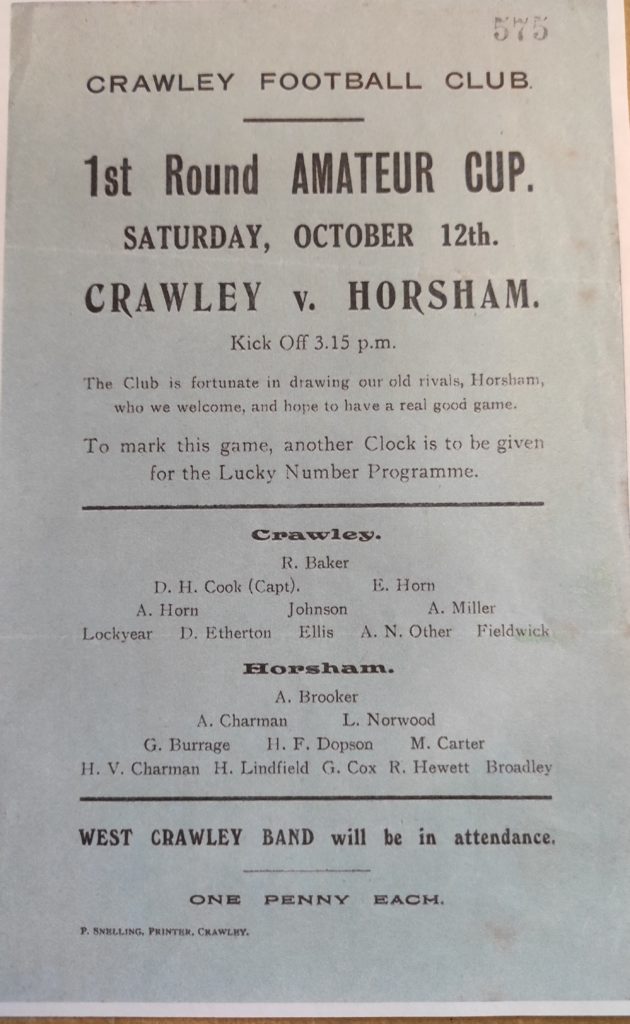
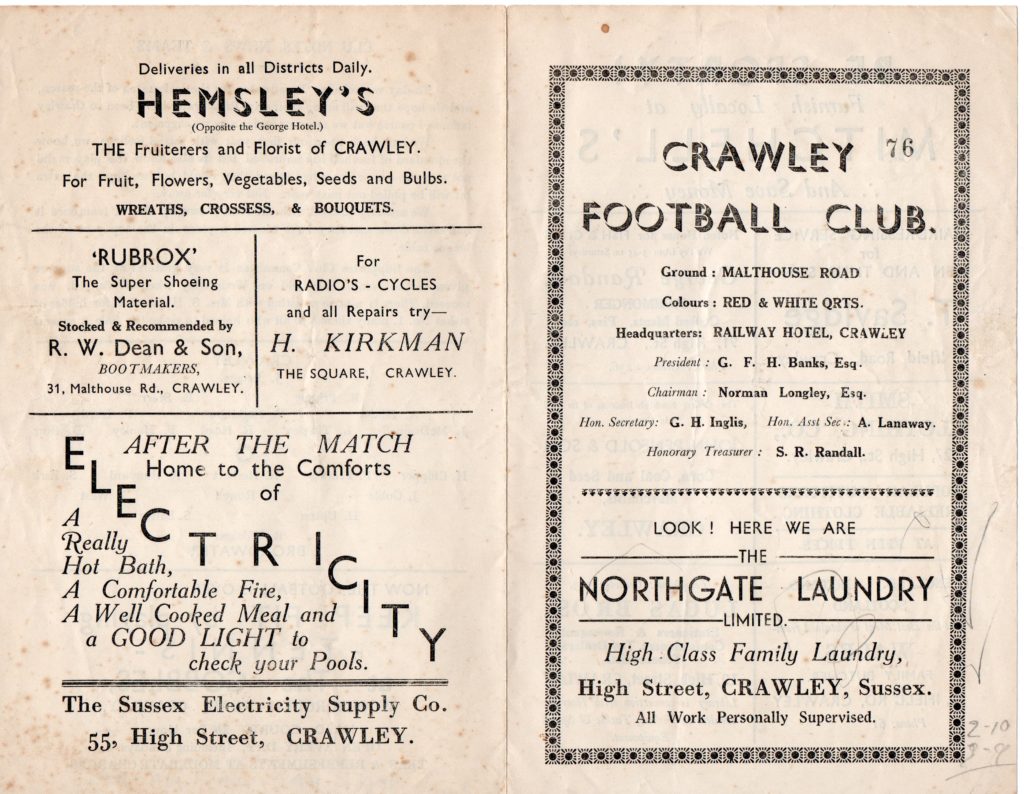
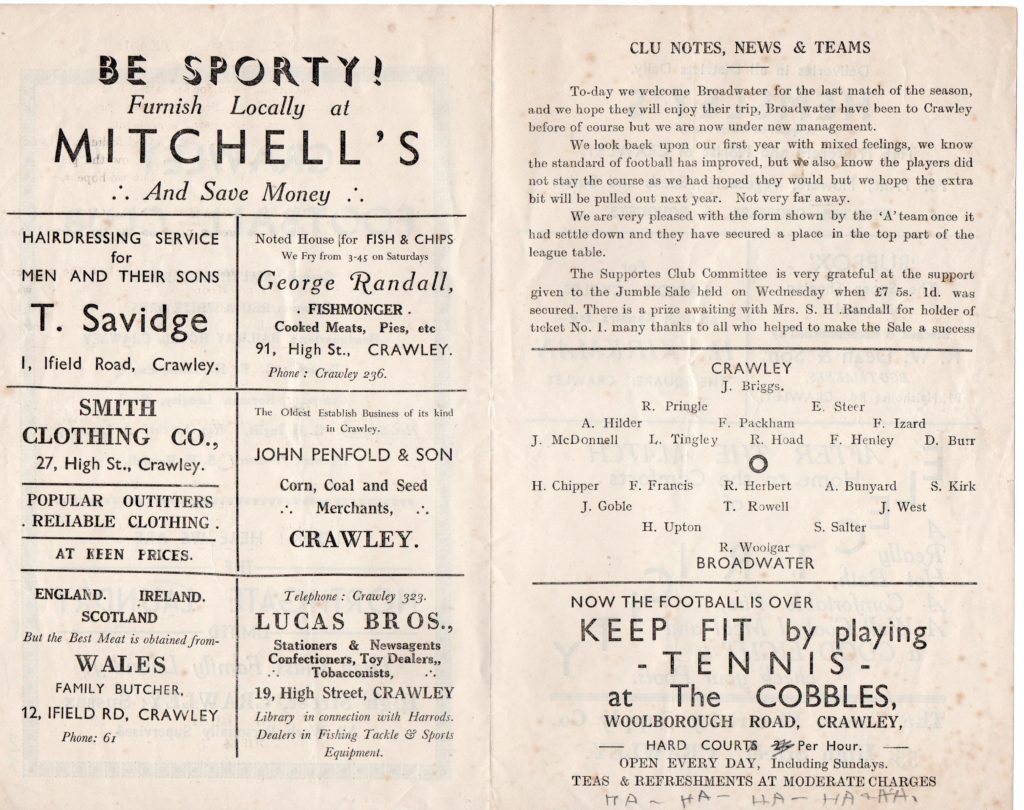
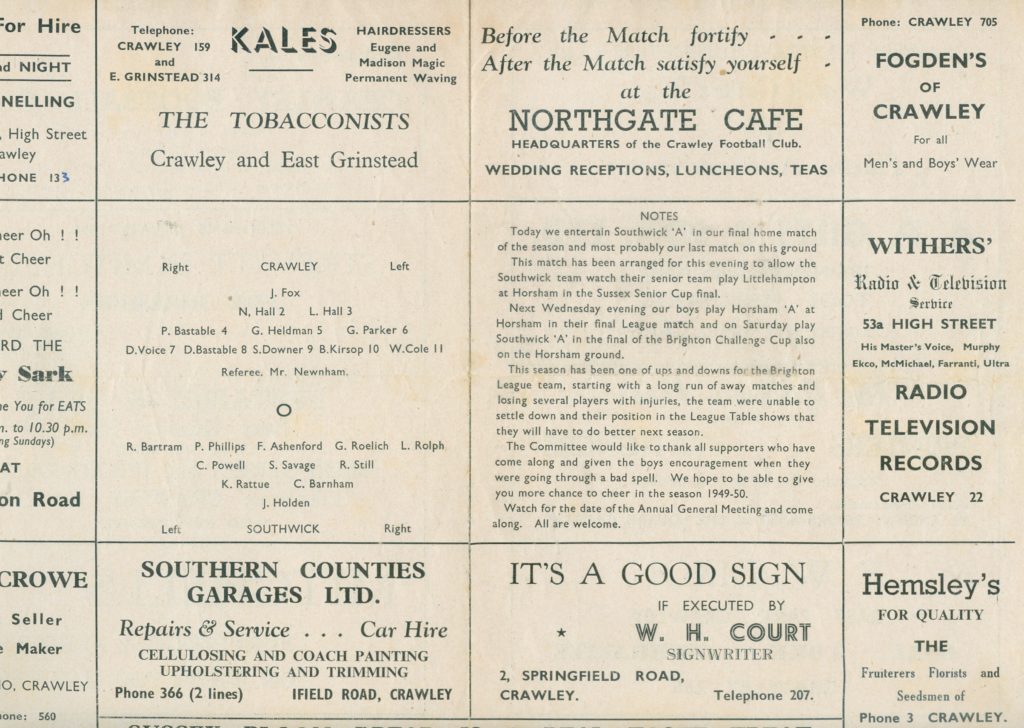
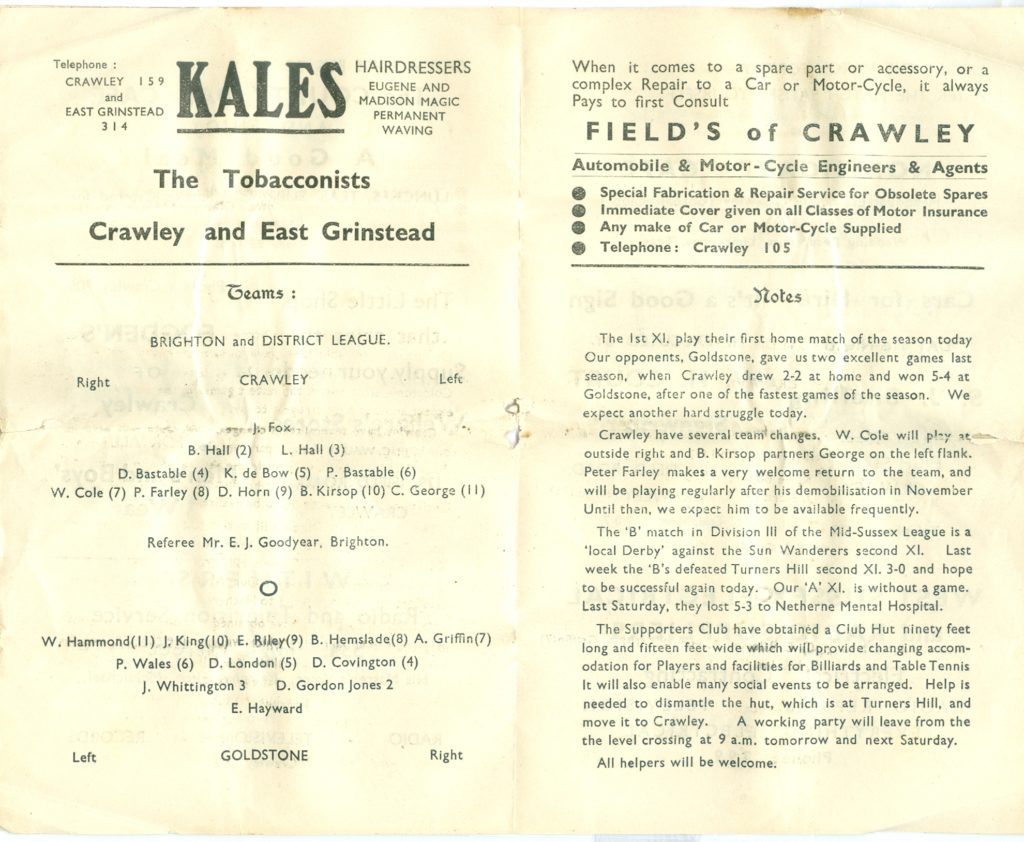
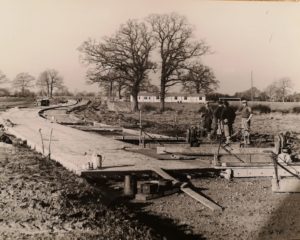

0 Comments